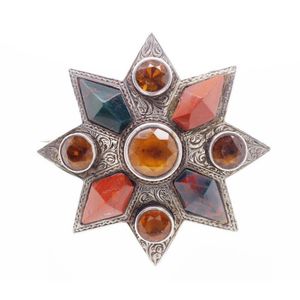Scottish Cairngorm Brooch with Agate and Citrine
Victorian Scottish silver cairngorm brooch unmarked. Approx length 40 mm, set with agate & citrine
You must be a subscriber, and be logged in to view price and dealer details.
Subscribe Now to view actual auction price for this item
When you subscribe, you have the option of setting the currency in which to display prices to $Au, $US, $NZ or Stg.
This item has been sold, and the description, image and price are for reference purposes only.
- Cairngorm - Cairngorm is a type of smoky quartz, which is a variety of quartz that ranges in colour from light gray to dark brown. It is found in granite rock in the Cairngorm Mountains of Scotland, hence its name, and it is typically found in large clusters. The mineral is relatively hard, with a Mohs hardness of 7, and it is fairly durable, making it a suitable choice for jewellery and decorative objects.
Cairngorm is said to have spiritual and healing properties, it is believed to have grounding energy, and it is thought to help with focus and concentration. It is also said to be a stone of protection and is said to help balance the energy within the body.
The mining and collection of Cairngorms is heavily regulated in Scotland, and it is illegal to remove them from the Cairngorms National Park without a permit. - Agate - Agate is a type of semi-precious gemstone that is made up of silica dioxide, a mineral that is also found in quartz. It is known for its distinctive banded patterns, which are created as layers of silica are deposited in different colours including red, orange, yellow, green, blue, and purple. It is often used in jewellery, decorative objects, and other decorative items, and it is prized for its beauty and durability. Agate is found in many parts of the world, including Brazil, India, and the United States.
- Victorian Period - The Victorian period of furniture and decorative arts design covers the reign of Queen Victoria from 1837 to 1901. There was not one dominant style of furniture in the Victorian period. Designers used and modified many historical styles such as Gothic, Tudor, Elizabethan, English Rococo, Neoclassical and others, although use of some styles, such as English Rococo and Gothic tended to dominate the furniture manufacture of the period.
The Victorian period was preceded by the Regency and William IV periods, and followed by the Edwardian period, named for Edward VII (1841 ? 1910) who was King of the United Kingdom and the British Dominions and Emperor of India for the brief period from 1901 until his death in 1910.
This item has been included into following indexes:
- brooches, depicting - Scottish thistle and cairngorm 43
-
brooches, set with
- agate 224
- citrine 145
- Scottish, hardstone and other 195
- brooches, silver - silver items 2,539
- jewellery - cairngorm stone 51
